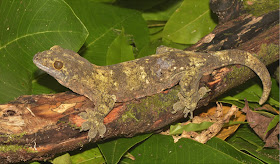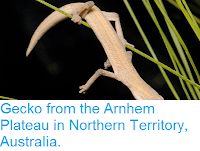The Bismark Archipelago is a large group volcanic islands to the east of Papua New Guinea. This wide scatting of mostly small oceanic islands is a biodiversity hotspot, with each island typically having its own flora and fauna descended from small numbers of individuals that managed to reach the islands after they rose from the sea. Despite this importance, the remote nature of the islands means that many are relatively unexplored by biologists, and the discovery of even quite large animals there is not unusual.
In a paper published in the journal Zootaxa on 14 December 2016, Paul Oliver of the Division of Evolution, Ecology and Genetics, Research School of Biology, and Centre for Biodiversity Analysis at The Australian National University, Jonathan Clegg of Aquatic and Terrestrial Ecology at the Royal Belgian Institute of Natural Sciences and the Biodiversity Inventory for Conservation, Robert Fisher of the Western Ecological Research Center of the U.S. Geological Survey, Stephen Richards of the South Australian Museum and Peter Taylor and Merlijn Jocque, also of Aquatic and Terrestrial Ecology at the Royal Belgian Institute of
Natural Sciences and the Biodiversity Inventory for Conservation describe a new species of Gecko from the Bismarck Archipelago.
The new species is placed in the genus Gehyra, which has previously been recorded from Southeast Asia east to the Ryukyu Islands and southeast to the islands of Melanesia and Oceania, and given the specific name rohan, which is the local name in the Nali language given to the species on Manus Island in the Admiralty Islands, a name requested by the people of Sohoniliu Village on Manus Island. The species is exceptionally large, reaching 130-150 mm in length, and brown in colour and mottled with patches of lighter brown, white, black and orange.
Specimen of Gehyra rohan from Mussau Island in the St Matthias Islands. S. Venter in Oliver et al. (2016).
The species was found at a number of separate localities on Manus Island in the Admiralty Islands, as well as possibly on the neighbouring islands of Los Negros and Nauna. It was also found on Mussau Island in the St Matthias Islands, and possibly Fiji. The species was found in both primary and disturbed lowland rainforest, living primarily in the trees, though the species was also found in and around Human habitations and in one case in a cave. One specimen was observed to 'glide' about 3 m to another tree when disturbed.
A molecular phylogenetic study suggests that Gehyra rohan is most closely related to Gehyra georgepottshaasti, a species found on Vanuatu, and Gehyra vorax, a species found in Fiji, but that it probably diverged from these species during the late Miocene; earlier than some estimates for the emergence of the Admiralty Islands, Fiji or Vanuatu. This suggests that the genus Gehyra has been in the region since at least the Miocene, possibly occupying a series of now vanished volcanic islands prior to the emergence of the modern islands.
See also...







